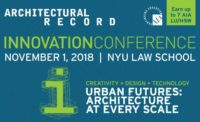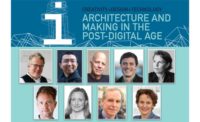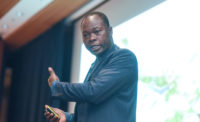“The power of the handmade shouldn’t be taken for granted,” said Michael Murphy, co-founder of MASS Design Group, a practice known for its humanitarian projects. Speaking at Architectural Record’s 19th Innovation Conference in New York last month, Murphy recalled that, after the 2010 Haiti earthquake, many proposals for shelters and clinics there involved prefabrication. “That made sense,” he said, “but the thing people needed were jobs.” His firm’s GHESKIO Cholera Treatment Center incorporated custom metalwork by Haitian artisans. “It’s not just about how we fabricate, but about how we fabricate with as many people as possible.”
Maximizing use of local labor is just one idea that was explored in the daylong conference built around the theme “Architecture and Making in the Post-Digital Age.”
Francine Houben, creative director of Mecanoo, showcased craftsmanship in her firm’s Bruce C. Bolling Municipal Building in Boston, devising complex masonry patterns that engaged the bricklayers. Brad Cloepfil, principal of Allied Works Architecture, spoke of his efforts to produce imperfectly formed concrete walls for his Clyfford Still Museum in Denver. Similarly, architect Annabelle Selldorf described her use of terra-cotta for three Manhattan condo buildings.
“We are past the initial infatuation with the digital,” argued KieranTimberlake partner Stephen Kieran. He described a series of models his firm built for a new building at Brown University. The models, he said, were “more wonderful, surprising, and compelling than any digital prototypes.”
Nearly every speaker agreed that partnerships are essential for innovation. “Architects don’t innovate alone,” said Kasper Guldager Jensen, senior partner of the Danish firm 3XN. His firm’s research division, GXN, is working with numerous partners on a house built of upcycled biowaste from agriculture and industry. Anna Dyson, founding director of the New York–based Center for Architecture, Science and Ecology, spoke of the partnership between Skidmore, Owings & Merrill and the Rensselaer Polytechnic Institute that brought her think tank into being. Among its projects is a hybrid biomechanical system that amplifies the air-cleaning capacity of indoor plants.
Japanese architect Sou Fujimoto also showed projects that bring nature and architecture into new relationships, such as a pinecone-like apartment building in Montpellier, France, with more than 200 projecting balconies. Tod Williams Billie Tsien Architects’s Andlinger Center at Princeton connects to nature by nestling within a series of sunken gardens. Tod Williams joked, “There’s very little innovation here.” But, somehow, in a design culture fixated on the digital, the simplicity of the lush greenery juxtaposed with the strong materials and feeling of craft seemed the most inventive of all.






Post a comment to this article
Report Abusive Comment